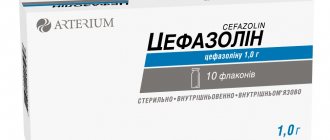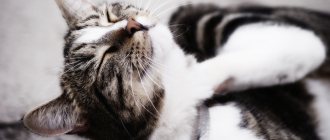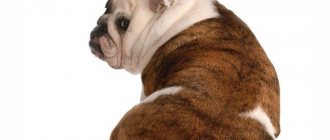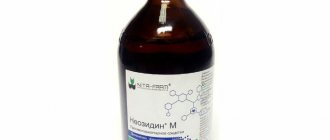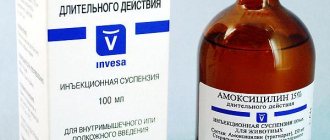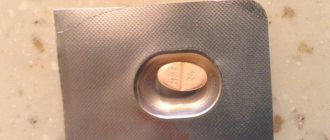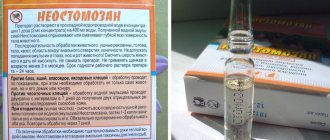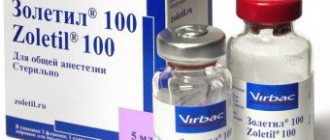Composition and action
The active ingredient of the drug is ketoprofen. It is quickly absorbed into the blood and spreads throughout organs and tissues. Ketoprofen reaches its maximum concentration in blood plasma within 7-10 minutes after intramuscular administration, and 30-40 after subcutaneous administration.
Due to its speed of action, the drug is actively used in symptomatic therapy to reduce pain and relieve inflammation. At the same time, the medicine does not affect the development and progression of acute or chronic disease.
Ketofen is available in several dosage forms:
- tablets with different contents of active substance - 5, 10 and 20 mg;
- 1% solution for injection.
Important! Clinical trials have shown that the administration of Ketofen for moderately severe pain improves the animal’s condition faster and more effectively than drugs containing ibuprofen or diclofenac. The main area of application is acute and chronic diseases of the musculoskeletal system. The medicine is effective for osteoarthritis and other musculoskeletal pain.
Precautionary measures
Be sure to read the instructions included with the tablets or solution. Observe the following rules:
- Wash your hands after handling the product
- if you are prone to allergies, use gloves;
- keep the medicine away from children;
- do not use the drug after the expiration date;
- store it in a dark place at a temperature no higher than 30 degrees.
After opening the package, use Ketofen within 28 days.
Purpose
The medicine is sold in veterinary pharmacies in the form of a ready-to-use 1% solution. 100 ml of injection solution contains 1 g of the active substance - ketoprofen. Ketofen is prescribed as an antipyretic, anti-inflammatory and analgesic drug for dogs with pathologies of the musculoskeletal system. The drug in injection form is effective:
- for arthritis;
- arthrosis;
- injuries (fractures, dislocations, sprains and tendons);
- muscle pain of a rheumatic and non-rheumatic nature;
- herniated intervertebral discs;
- post-traumatic inflammation of soft tissues and the locomotor system (bruises, ruptures, ligament damage).
As a strong pain reliever, Ketofen is prescribed to relieve pain and inflammatory reactions after surgical interventions. It effectively eliminates the provocateurs of inflammation and pain in tissues and relieves inflammation and its symptoms - swelling, redness, pain.
Important! The drug has antipyretic properties, so it is prescribed for infections accompanied by an increase in body temperature.
General information
Ketofen is produced in the form of an injection solution and tablets with different percentages of ketoprofen content. The dosage is regulated by the weight of the animal; when injections are prescribed, 0.2 ml of solution is for every kilogram or 0.1 mg of tablet substance. Single dose, for 3 days - in case of injections, 4 - in dry form. Follow these rules, as exceeding the dosage is fraught with negative consequences, including death.
As a rule, the use of the drug is due to:
- Injuries (fracture, dislocation);
- Bruises;
- Hernias in the spine;
- Destroyed intra-articular cartilage;
- Inflammation in the joint (arthrosis).
Treatment regimens and dosage
For chronic and acute pathologies of the osteoarticular system, the medicine is prescribed in a course. Injections for dogs are given subcutaneously, intramuscularly or intravenously. The standard dosage provided for in the instructions is 2 mg of ketoprofen per 1 kg of animal body weight. Converted to a 1% solution, this dose is 0.2 ml per 1 kg of dog weight.
Only a veterinarian can determine the need and possible effect of taking the medicine. He will draw up a treatment regimen that depends on the results of clinical studies, the degree of development of the disease, and the condition of the animal.
Injections are recommended for acute pain, as emergency aid for injuries and in the postoperative period. If necessary, your veterinarian may prescribe follow-up treatment with tablets. The dose is 1 mg of ketoprofen per 1 kg of animal body weight. Different types of tablets (5, 10 or 20 mg) are convenient for precise dosage when treating small, medium and large breed dogs. Typically, the course of taking the drug is limited to 3-4 days.
Important! Ketofen should not be taken simultaneously with other NSAIDs, anticoagulants (blood thinners), and diuretics.
Ketofen for dogs: reviews
Valery. We have an old South Russian Shepherd with arthrosis and could barely walk. 3 injections of Ketofen at the veterinary hospital saved me. Now he doesn’t run like he did in his youth, of course, but he gets ready for a walk quite cheerfully.
Dog owners note that Ketofen quickly relieved their pets of pain.
Valentina Nikolaevna. Without looking, I pressed my Margot’s paw under the door. We cried with the dog at the veterinarian... I’m still ashamed of the dog. She didn't lean on her paw at all. The doctor said that it was just a bruise, he recommended injections, but we only managed one, then we were given pills at home for 4 days - we didn’t need any more.
Elvira. Ketofen personally helped us a lot after the operation. They removed a soft tissue tumor, in my opinion, our Thai Ridgeback was in a lot of pain, until Ketofen whined a lot. And then I immediately fell asleep. They gave it for 4 days, give it longer - they were afraid of side effects. And the dog had already become calmer by that time.
Kostya. We also bought Ketofen when our Yorkshire terrier unsuccessfully jumped off the couch. Out of nowhere - a dislocated paw. And he squealed, by the way, as if he had broken it. The vet gave me one injection, adjusted it and gave me pills to take home for 3 days. A month later he jumps off the same couch again.
Special conditions and restrictions
It is necessary to adhere to the treatment regimen drawn up by the veterinarian and give injections and give the dog tablets at the same time. If you miss a dose, give the medicine as soon as possible and start treatment again without changing the dosage.
Ketofen is a potent drug, its action is equivalent to narcotic analgesics, so it should be used carefully and only as prescribed by a veterinarian. The drug should not be used:
- with individual intolerance;
- chronic pathologies of the gastrointestinal tract (gastritis, peptic ulcer;
- bleeding tendency;
- renal failure;
- hemorrhagic syndrome.
Important! For diseases of the heart, liver, and kidneys, the medicine can only be used under the supervision of a veterinarian. If there is a need to use Ketofen in pregnant females, the doctor must assess the possible risk for the dog and its offspring.
Uncontrolled use of the medication is dangerous; the medication can cause intestinal irritation and vomiting. They usually go away on their own, but if vomiting, diarrhea or other symptoms continue, you should contact your veterinarian.
In case of overdose, bleeding in the gastrointestinal tract (manifested by dark vomit) and other unpleasant symptoms are possible:
- nausea and vomiting;
- increased salivation;
- development of gastric ulcer;
- gastritis.
Analogues of the drug according to indications for use
The following drugs are analogues of Ketofen:
- Ainil 1% (Ainil 1%);
- Flexoprofen;
- Nalbuphine (Nalbuphinum).
Photo gallery: Ketofen analogues
Ainil's formula was developed in Spain, but this drug is produced in many countries. Flexoprofen is packaged in 5, 10, 20, 30, 50, 100, 200 and 250 ml in dark glass bottles. Nalbuphine is a drug developed for the treatment of people, but it is used and in veterinary medicine
Table: comparison of Ketofen analogues
| Name | Developer | Release form | Active substance | Action | Contraindications | Best before date | Price |
| Ainil | Industrial veterinaria SA (Spain) | Injection | Ketoprofen |
|
| 2 years | From 1100 rubles per 100 ml |
| Flexoprofen | "VIC - animal health" (Russia) |
| 3 years | From 260 rubles for 10 ml | |||
| Nalbuphine | Federal State Unitary Enterprise "Moscow Endocrine Plant" (Russia) | Nalbuphine hydrochloride |
| Individual intolerance to the components of the drug | 2 years | From 850 rubles for 10 ampoules (5 ml each) |
Contraindications.
When considering any medication, in order to use it correctly to treat your pet, you must understand the circumstances in which the drug will give the desired effect, and in which cases you will not be able to see the expected effect.
First of all, Ketofen for cats copes well with the problems of the animal’s musculoskeletal functions. The most common diseases of this type are herniated discs, arthrosis and arthritis. Whatever the disease of the animal, or your speculation about the essence of the problem, you should use the medicine only after examining the animal by a veterinarian. It is he who will prescribe the drug and its dosage to you.
Another important and quite extensive area of application of Ketofen is injuries.
By trauma we can understand:
- Dislocations.
- Fractures.
- Sprained ligaments and muscles.
In this case, the indication for the use of this drug will be acute and prolonged pain in the pet. Under such circumstances, we can talk about the beginning of an inflammatory process that needs to be eliminated as soon as possible.
Experts, in their thoughts on the use of the drug, are almost unanimously inclined to believe that Ketofen should be used by an animal only when severe pain is accompanied by high fever.
The drug is considered quite strong, and veterinarians do not recommend its use for minor manifestations of pain in an animal.
Animals with chronic forms of musculoskeletal problems deserve special attention. If several types of medicine are used, then mandatory consultation with a specialist on their compatibility is necessary. Not all drugs have a positive effect on the animal when used simultaneously.
Even though the drug in question is a non-steroidal drug, this does not mean that its use is appropriate in all cases. Before use, be sure to familiarize yourself with the contraindications for the use of Ketofen in cats. This knowledge will help you prevent unnecessary suffering of the animal from exacerbation of diseases that may be caused by the action of the drug.
The use of Ketofen is undesirable if cats have the following problems:
- Haemorrhoids. In this case, the use of tablets is highly discouraged. The use of the medicine may cause prolapse of hemorrhoids or their inflammation. The risk of internal bleeding and, along with it, infection entering the animal's bloodstream may increase.
- Peptic ulcer of the duodenum, stomach or kidney failure are serious reasons for refusing this drug. For peptic ulcers, injections can still be used, however, only if absolutely necessary. For kidney problems, both types of medicine will seriously aggravate the picture of kidney failure.
- It is also unacceptable to treat an animal with Ketofen that is already being treated with another non-steroidal drug, anticoagulants or diuretics. A weakened body may react negatively to a complex attack of ailments.
- Individual intolerance of the animal to individual components of the drug. But it is quite difficult to find out about this. If there is an urgent need for use, then, as a rule, there is not much time to think. In this case, you should start the drug in small doses and monitor the cat’s body’s response to the drug.
We invite you to familiarize yourself with: Characteristics and appearance of the Burmese cat breed
In each of these cases, it is imperative that the animal be examined by a veterinarian. There may be individual cases in which the drug cannot be used, and there may be the opposite, when for a certain form of the listed problems, the use of the drug in limited quantities will be appropriate.
Indications for the use of this drug are diseases such as:
- acute and chronic diseases of the musculoskeletal system;
- postoperative condition;
- arthrosis, arthritis and hernias.
The owner gave the pet a pill and he began to salivate. Then the incessant vomiting began. “Matroskina” in an armful and rinse the stomach, the faster, the better for the tailed one. There are especially delicate individuals - they are allergic to everything possible. We noticed red spots in the “patient’s” ears; the use of “Ketofen” was immediately stopped.
Cat injection. Common mistakes
Do not give the product to pets with the following diagnosis:
- haemorrhoids;
- gastrointestinal ulcer;
- renal failure.
Some animals exhibit specific individual intolerance to certain components of the drug. In this case, it is important to stop using the pharmaceutical product and contact a specialist. You may need to prescribe antihistamines.
It is better to start a course of treatment with Ketofen with minimal doses in order to check the behavior and reaction of the animal to the drug.
